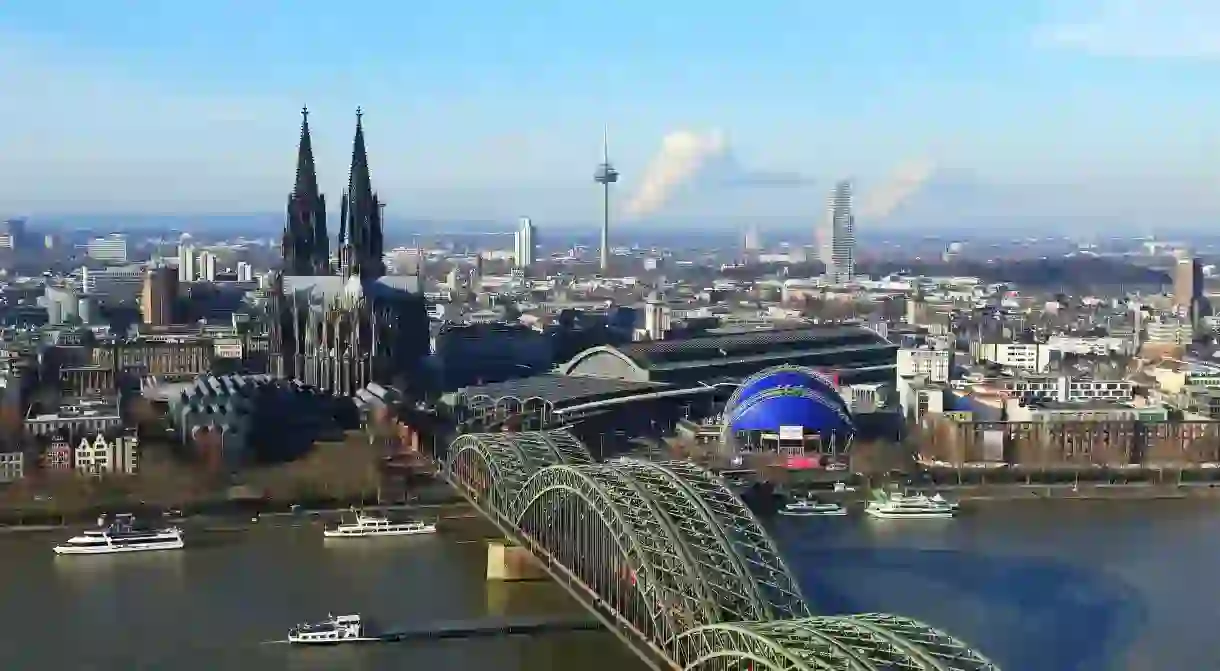A Tour of Cologne's Architectural Landmarks

When more than three-quarters of a city’s buildings are destroyed, and hundreds of thousands of people are in need of a safe place to live, it’s hard to prioritise architecturally significant buildings. That was the situation in Cologne after World War II and meant that most of what was built in the 1950s came from the ‘ASAP’ school of architecture. Eventually the city was back on its feet, and architects were given the chance to build something that would really stand out – and they jumped at the opportunity.
Colonius Tower
Shop

Like the Fernsehturm in Berlin, the T-Mobile tower in Cologne is a major landmark. A quick tour through the souvenir section of any shop will show the modern spaceship on a stick defining the Cologne skyline. Finished in 1981, and standing 266 metres (872ft) tall (including the radio tower point), Colonius had a restaurant, office space and a viewing platform. Since the 1990s, however, the tower has had no tenant and functions only as a very tall billboard for mobile phone provider T-Mobile.
Eigelstein 115
Building

Cologne’s narrowest building is just 2.56 metres (8.39ft) wide and 30 metres (98ft) long, so narrow that it doesn’t even have its own walls. One of the key points in Arno Brandlhuber’s renovation was to use the walls of the neighbouring houses as the exterior walls of Eigelstein 115, to save space, but the fully glazed facade means that the offices and apartments inside still feel surprisingly spacious. It cost about €550,000 (£463,867) to build in 1997, and has won numerous awards.
Immanuel Church and Parish Centre
Church
Sauerbruch Hutton’s design for the Protestant Brückenschlag parish in Cologne created an innovative, modern place of worship, and features a small chapel and bell tower as well as the church itself. With a facade clad in diagonally laid timber planks, it blends in beautifully with the surrounding nature. Inside, the simple yet striking details include a coloured timber screen behind the altar, as well as unclad timber columns. It’s a very untraditional take on a traditional building.
WWF Medien and Service GmbH WDR-Arkaden
Building, Store
Known as one of the architectural icons of the popular German architect Gottfried Böhm, the building was actually designed by his wife Elisabeth and son Peter. The mostly glass building is home to the offices, cafeteria and studio of Cologne broadcaster WDR. Even today, glass and steel aren’t commonly used for buildings in Cologne – and even more unusually, the playful building from 1996 has aged well.
Peek and Cloppenburg
Building, Store

It’s quite a bold statement for a clothing store to commission its building from one of the world’s leading architects, but Peek & Cloppenburg does it for every single one of its German shops. The Cologne branch, a spectacular glass building on Europe’s busiest shopping street, was designed by Renzo Piano and opened in 2005. Called the Weltstadthaus, or World City Building, the 4,900-square-metre (52,743-square-foot) glass facade is constructed from 6,800 individual panes and 66 laminated beams made from Siberian larch.
Kranhäuser
Architectural Landmark

When the old Cologne port was rezoned for commercial and residential use in the early 2000s, architects swarmed to renovate the old warehouses and build new, imaginative buildings on the now-available land. The Kranhäuser, or Crane Buildings, were designed by Alfons Linster and Hadi Teherani as an homage to the loading cranes that used to line the docks. The set of three includes 16,000 square meters (172,222 square feet) of office space and 133 luxury apartments.
St Gertrude
Church
Designed by Gottfried Böhm in 1960, the Brutalist, asymmetric St Gertrude church, built entirely from concrete, won the Cologne Architecture Prize in 1967. Inside, the nave resembles a cave and is lit to create warmth and calm. The thick wall keeps out the noise from the train tracks, and the sparse decoration continues the minimal theme. Three chapels with high, pointed rooflines and a 40-metre (131-foot) tower face the street.
MediaPark
Building

The focal point of MediaPark, a completely new neighbourhood near Christophstraße in the centre of the city, is the 148-metre (485-foot)-tall KölnTurm designed by French architect Jean Nouvel. The rest of the project, which includes office space for over 250 companies employing 5,000 people, was designed by Eberhard Zeidler and took 14 years to build. The buildings are surrounded by parks along the train tracks, and have their own small lake.
Cologne Central Mosque
Mosque

Finally opening in June of 2017 after years of construction delays and disagreements, the DITIB Mosque in Ehrenfeld is determined to be a place for all Kölners. The architect, Paul Böhm, is the son of the church-building architect Gottfried Böhm, and all visitors are encouraged, including women. Head scarves are not required, but as in cathedrals, it is respectful to cover legs and shoulders.
Additional reporting by Cajsa Carlson













